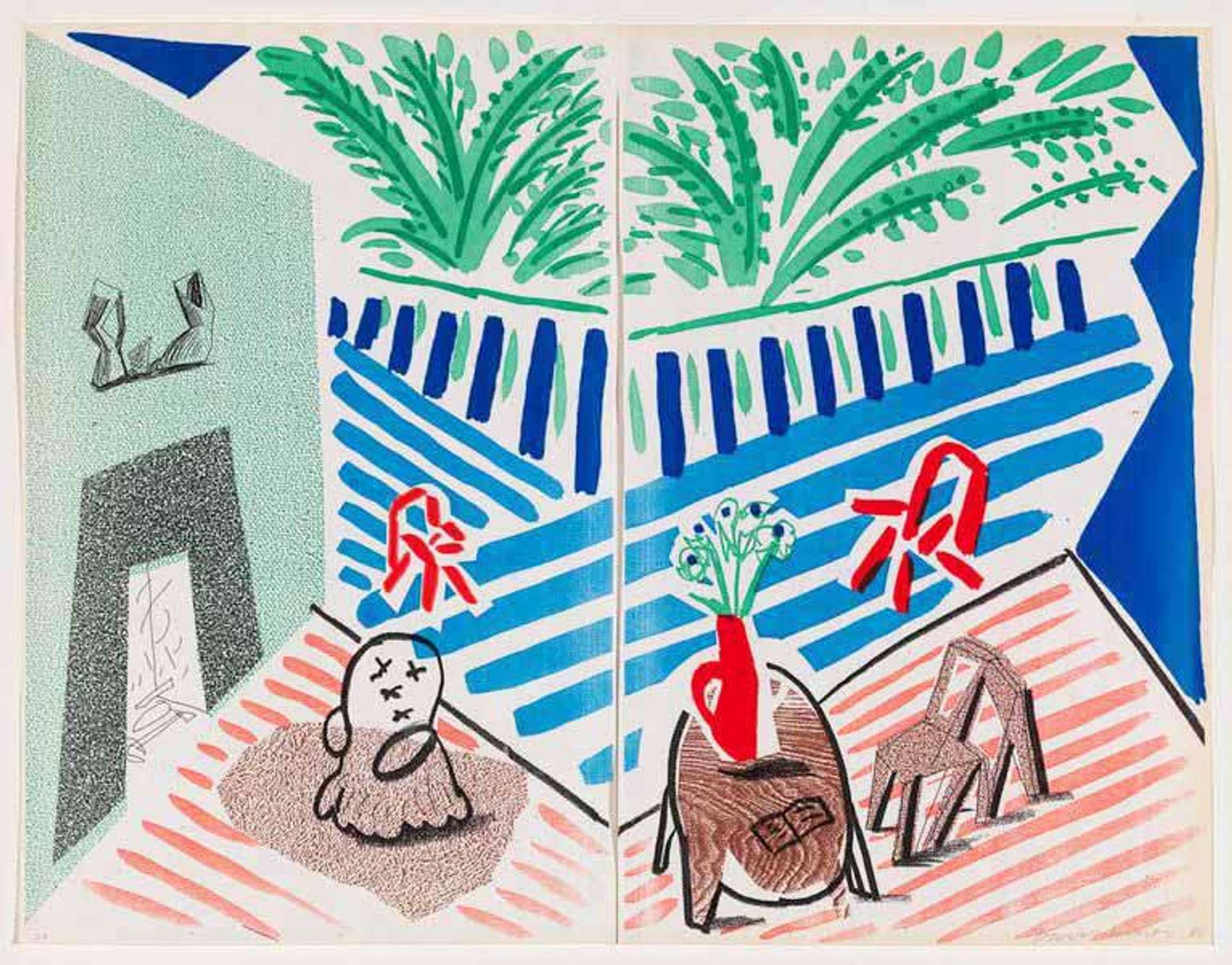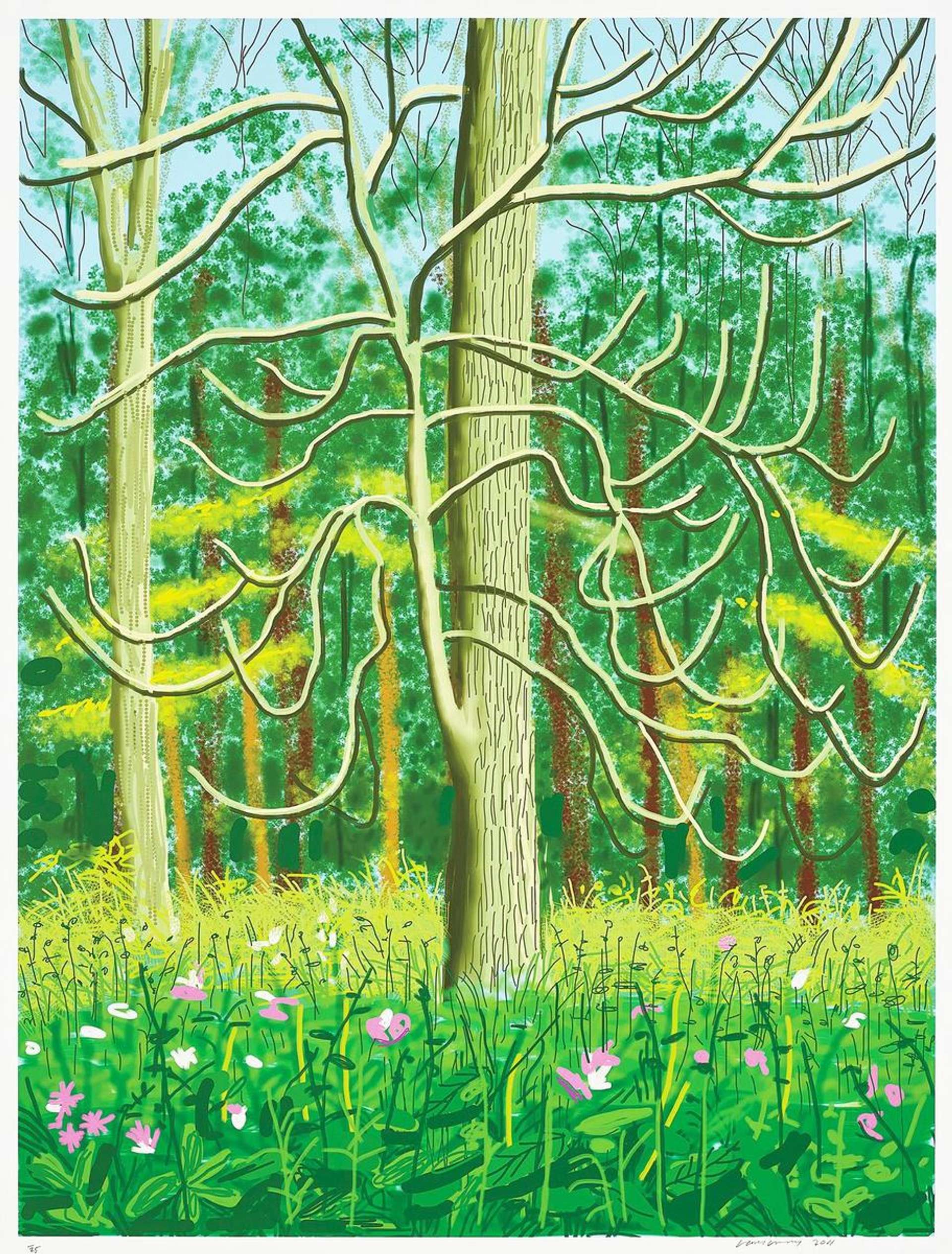 Twelve Fifteen © David Hockney 1991
Twelve Fifteen © David Hockney 1991
David Hockney
651 works
Considered one of the most influential artists in British art history and a leading figure in the Pop Art movement of the 1960s, David Hockney has led a uniquely prolific career that spans over six decades. Although best known for his bright acrylic depictions of pool-side life in Southern California, and his Arrival of Spring landscapes in East Yorkshire, David Hockney has worked across a broad range of mediums, including watercolour, photographic collage, and, most recently, iPad art.
Here are some of Hockney’s most important exhibitions - demonstrating both his artistic versatility, and his life-long dedication to never resting on his laurels:
David Hockney: Pictures with People In (1963, Kasmin Limited, London)
The first solo David Hockney exhibition was in 1963, just one year after the artist's graduation from the Royal College of Art, at Kasmin Limited in London.
Meeting David Hockney in 1961 after purchasing an earlier work of his featured in that year’s RCA’s Young Contemporaries exhibition, prominent art dealer John Kasmin described the artist as a shy, impoverished and dark-haired young man. Kasmin was so impressed with the then-student’s skill, however, that he agreed to represent his work for the next three years. The resultant show, which included paintings and sketches completed by David Hockney during a trip to Egypt earlier in the year, was a critically acclaimed sell-out.
Paintings, Prints and Drawings, 1960-1970 (1970, Whitechapel Art Gallery, London)
The first major retrospective of Hockney’s early works opened in London’s Whitechapel Gallery in April of 1970, before traveling to three other European institutions. David Hockney himself, now recognisably bleached-blond, was involved in the selection of the 45 paintings and 47 drawings featured. He escaped to France as they were installed, however, returning only the day before the exhibit opened, afraid his earliest works were now “going to look terrible”. Having seen the exhibit, he later decided “they’re not that bad”.
The show, which celebrated the first 10 years of Hockney’s career, featured Le Parc des Sources, Vichy, a portrait of his lover Peter Schlesinger and friend Ossie Clark seated, with their backs turned, in a well-manicured French park, as well as Four Different Kinds of Water and Savings and Loan Building, more recognisable images inspired by his years in Southern California.
Designs for The Rake’s Progress (1975, Bristol City Art Gallery, Bristol)
David Hockney was commissioned by the Glyndebourne Festival Opera in 1975 to design the sets and costumes for a production of The Rake’s Progress - a three-act avant-garde opera by Igor Stravinsky.
Having previously created his own etchings under the same title, similarly inspired by William Hogarth’s 1735 engraving series, David Hockney was well suited to the task — mirroring the original prints through the artful use of typical engraving techniques such as cross-hatching and parallel lines. The result was a playfully whimsical set design, which aptly matched the opera’s absurdist libretto, written by W. H. Auden and Chester Kallman.
The project, the first of many forays into the world of theatre, opera and ballet, demonstrated Hockney’s versatility, and allowed him a brief respite from painting. “I said long ago that I thought of all my painting as drama”, Hockney explained, describing his three years working in theatre as “another liberation, a new kind of space for me”.
David Hockney photographe (1982, Centre Georges Pompidou, Paris)
Though long-skeptical of photography’s capacity for complexity, Hockney was convinced by curator Alain Sayag to put on a show of his photographs at Paris’s Centre Pompidou in 1982. The project led to a breakthrough for Hockney, who, in the process of documenting his extensive photographic collection, began to use his Polaroid camera for a new purpose - combining composite images to reveal multiple viewpoints in a single piece of art.
The method was a further innovation on his existing habit of combining multiple snapshots to plan large-scale paintings, and became a staple technique for the artist in the following years. The Pompidou show, which featured an overview of Hockney’s personal photographs as well these new creations - of which David Hockney quickly produced over 150 - left critics lauding his experimentation, with one even comparing the resultant manipulation of perspective to that of one of Hockney’s long-time idols, Cubist Pablo Picasso.
David Hockney: A Retrospective (1988, Los Angeles County Museum of Art, Los Angeles)
Hockney’s second major retrospective followed 18 years after the first, presented at the Los Angeles County Museum in California. Made up of 250 paintings, prints, drawings and photographs, the collection became the most well-attended exhibit in LACMA’s history, later traveling to the Metropolitan Museum of Art in New York, and the Tate Gallery in London.
Hockney’s panoramic ode to his daily commute from home to studio, Mulholland Drive: The Road to the Studio, featured prominently in the show - the largest of Hockney’s paintings on a single canvas. The image, completed in 1980, was one of many inspired by the artist’s great love for Los Angeles’s sun-drenched swimming pools, gently curving highways, and lush scenery. Its bright colours, bisected by winding roads, force the viewer to visually traverse the painting as an automobile might cut through the Southern Californian country-side. “You drive through the painting”, explained Hockney, “or your eye does, and the speed it goes at is about the speed of the car going along the road. That’s the way you experience it.”
David Hockney Portraits (2006, Museum of Fine Arts, Boston)
Hockney’s first major portrait exhibition began at the Museum of Fine Arts in Boston in 2006, appearing in both LACMA and the National Portrait Gallery in London before the year’s end.
The exhibition, an overview of Hockney’s career through a chronicle of his public and personal relationships, was made up of over 250 works, and demonstrated the range and inventiveness of his artistic style over the span of 5 decades. The portraits featured Hockney himself, his close friends and family, and the various cultural icons he consorted with, including W. H. Auden, Christopher Isherwood and Andy Warhol.
David Hockney: A Bigger Picture (2012, Royal Academy of Arts, London)
David Hockney rejected the idea of a retrospective for the Royal Academy of Art’s 2012 exhibition of his work, choosing instead to theme the exhibition around his East Yorkshire landscapes.
Some of the over-150 works took over entire walls of the gallery, depicting the verdant trees and tunnels of Hockney’s native Yorkshire. Amongst the more traditional watercolours and oil paintings were pieces created by Hockney’s newest medium of choice: the iPad.
Although the show enjoyed a relatively short run - a mere three months - A Bigger Picture became one of the most attended exhibitions in British history, drawing in a whopping 600,000 visitors. The same year, Hockney was awarded the Order of Merit by Her Majesty Queen Elizabeth II, the most prestigious honour for achievement in the arts, held by only 23 other living recipients.
82 Portraits and 1 Still-Life (2016, Royal Academy of Arts, London)
82 Portraits and 1 Still-Life opened at the Royal Academy of Arts in 2016, the culmination of a series of portraits Hockney began working on 3 years prior.
Hockney’s return to portraiture started with a likeness of his studio manager, and blossomed to include a motley crew of family, friends, fellow artists, curators and gallerists. Each painting is the same size, depicting the sitter in the same chair, against the same striking blue background, and was completed in a three-day time span.
David Hockney considered the installation a single work of art, a snapshot of the Los Angeles art world he retreated into following his monumental landscape exhibitions of the early 2010s. Evidence of Hockney’s distinct sense of humour, the lone still-life in the exhibition - a collection of fruit and vegetables arranged on a bench - was painted to replace a last-minute sitter cancellation.
David Hockney (2017, Tate Britain, London)
In honour of his 80th birthday, Hockney finally agreed to a full-life retrospective, in lieu of the thematically-based shows featuring more recent work that he had previously insisted on.
Co-organised by Tate Britain, Centre Pompidou and the Met, the retrospective featured a broad swath of work from 1953 to 2017, and quicklybecame one of the most visited single-artist exhibitions ever. More abstract works from Hockney’s student days featured alongside his Yorkshire landscapes, photo collages, a self-portrait or two, and recognisably bright scenes of scantily-clad Californian pool-swimmers.
Hockney's Eye (2022, Fitzwilliam Museum and the Heong Gallery, Cambridge)
In the spring and summer of 2022, Hockney’s use of new technologies became the subject of a ground-breaking exhibition, Hockney’s Eye, held at both The Fitzwilliam Museum and The Heong Gallery in Cambridge. A dramatic encounter with the likes of Andy Warhol, Claude Monet, and John Constable, Hockney’s tradition-breaking artworks were shown alongside those of the art historical canon to which they refer. The new exhibition displayed Hockney's drawings and paintings from early in his career to the present day.
What makes the exhibition unique? It is the first to explore pictures, picture-making and digital artworks through Hockney’s eyes, and features portraits, landscapes, differing perspectives on perspective, his use of the camera lucida and a real-life camera obscura.
Perspective Should Be Reversed (2023–2024, Honolulu Museum of Art, Hawaii)
From November 2023 to March 2024, Perspective Should Be Reversed at the Honolulu Museum of Art stood as the largest print-focused exhibition of Hockney’s career. This comprehensive show explored Hockney’s continuous reimagining of visual perception and perspective, covering six decades of work from the 1950s through to 2022. With nearly 200 pieces, the exhibition showcased an array of media, from traditional prints and Polaroid collages, to iPhone and iPad drawings. Curators Katherine Love and Catherine Whitney organised the collection into thematic sections that reflected Hockney’s exploration of dualities within his work, such as interiors and exteriors, balance and tension. Notable works like Landscape with Shadows and Rain on the Pond highlighted Hockney’s masterful integration of cubism and his evolving interest in digital media, revealing his ongoing fascination with capturing the experience of seeing multiple perspectives at once. Perspective Should Be Reversed provided visitors a vivid journey through Hockney’s groundbreaking use of perspective and technology, offering insight into the artist’s enduring impact on contemporary art.
Following its Honolulu debut, Perspective Should Be Reversed will travel to the Palm Springs Art Museum, California, from November 2024 to March 2025. The exhibition will continue to offer audiences an in-depth look at Hockney’s innovations in perspective and his dynamic use of multi-media across his extensive career.











